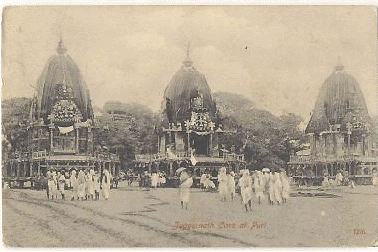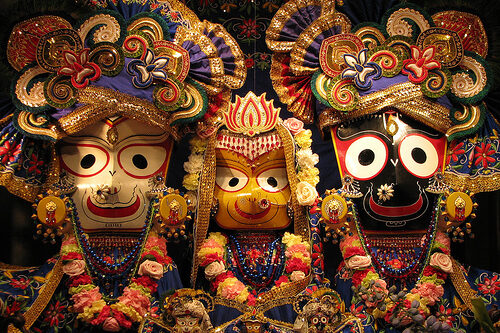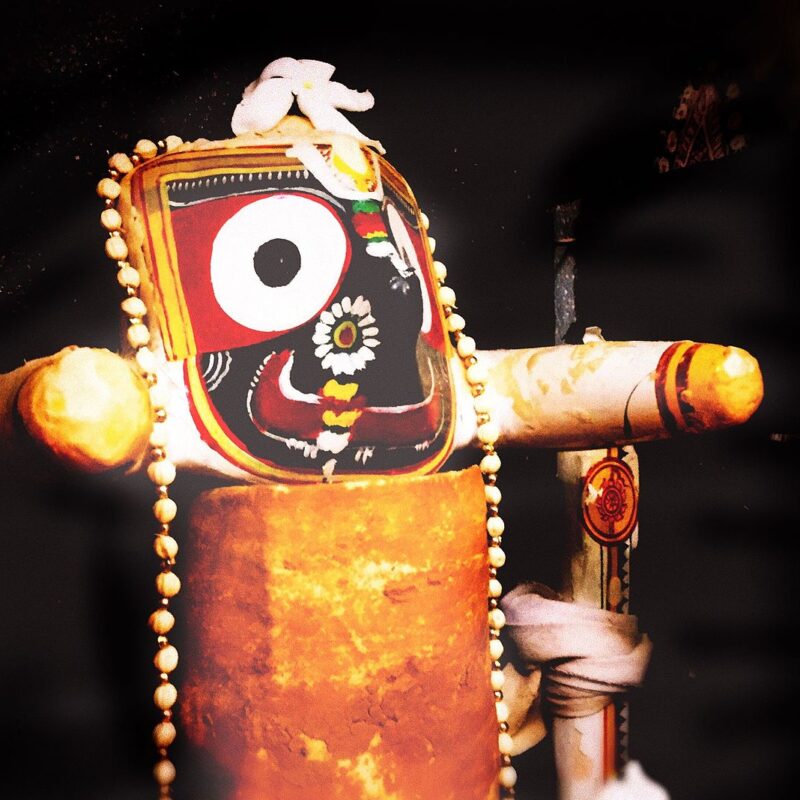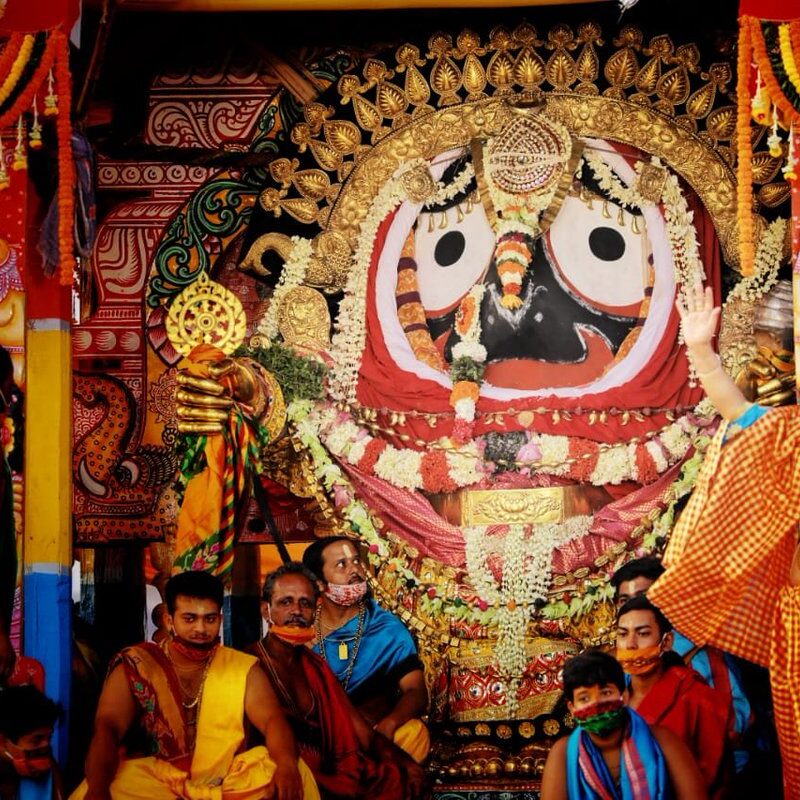
1) What is Ratha Yātrā?
Known also as the “Festival of Chariots,” Ratha Yātrā is an ancient celebration observed in the Indian city of Puri every year during Āshādha (June-July), the fourth month of the Hindu calendar, in which the sibling deities of Jagannātha, Baladeva, and Subhadrā are each placed on three-story high chariots and pulled almost two miles by devotees from the Jagannatha Temple to the Gundicā Temple, two of the most famous temples in Puri.
Two weeks before the actual procession, festivities begin on a day called Snāna Yātrā, when the deities are taken out of the temple for abhisheka, a ceremony where the deities are bathed by priests as the public get to take darshana (see their auspicious forms).
In Hindu culture, the act of cleansing the deity allows a worshiper to not only perform a sacred service, but the process also purifies the atmosphere, as well as the mind and sense.
After their long bath, the triad are said to get ill (learn more about the symbolism of this below), and are thus taken inside and kept in a private room to be quarantined for 15 days. During this period, they can only be seen by temple priests, who give them a new coat of paint, and offer them herbal remedies for their symbolic recovery.
When the quarantine is over, the siblings are taken out of the temple room, placed on their chariots, and brought to the Gundicā temple, as hundreds of thousands of devotees dance and sing their glories all along the way.
Today, the Ratha Yātrā festival is organized in cities all over the world, including across the U.S., by the International Society for Krishna Consciousness (ISKCON).
2) Who are Jagannātha, Baladeva, and Subhadrā
According to Gaudiya Vaishnavism — one of the major Hindu sects today and the spiritual lineage to which ISKCON belongs, Jagannatha is known as the “Lord of the Universe,” and is a form of Lord Krishna, who is considered to be the source and ultimate form of the Divine, while other traditions view him as an avatar of Vishnu.
In the Srimad Bhagavatam, a holy text narrating Krishna’s pastimes, Krishna is described as originally being born in the city of Mathura about 5,000 years ago. Due to threats on his life, however, his father brought him to a village called Vrindavan, to be raised in secret by adopted parents.
Because Vrindavan is where Krishna grew up, the village is very dear to him. It is where he is a simple cowherd boy, who gets to play with his closest friends and spend time with his childhood sweethearts, called the gopis, without the formalities that are attached to being a king, which is what he becomes when he grows up. As espoused in Gaudiya Vaishnava literature, the residents of Vrindavan are the most devoted individuals to Krishna in existence, and the gopis are foremost amongst them. The love the gopis have for Krishna is so strong, it is said he is forever indebted to them.
After his childhood, Krishna left Vrindavan and became the king of Dwarka, a city on the coast of northwestern India. Though Krishna never physically returned to Vrindavan, he constantly remembered the gopis, and in his absence, they could never forget him.
While in Dwarka, during a particular period of time he had been sorely missing the gopis, Krishna heard news of their condition. Apparently, since his departure, they had fallen into deep lamentation, and were experiencing perpetual heartbreak due to his absence.
Upon hearing of their love and affection, his eyes became large and filled with tears, as his hair stood on end. Falling into an ecstatic state caused by feelings of intense love due to separation, his extraordinarily profound feelings began to affect him physically, so much so, that his arms and legs contracted and his mouth grew into a wide smile.
Seeing his transformation, and understanding what the gopis meant to Krishna, Baladeva (his brother) and Subhadra (his sister) fell into a similar state.
Hence, the deities of Jagannatha (painted black), Baladeva (painted white), and Subhadra (painted yellow), are the siblings in this mood of love amplified by intense longing.
3) Spiritual significance of Ratha Yātrā
Spiritually speaking, Ratha Yātrā has an external cause — one that is widely understood by the public, and an internal cause — one that is a little more esoteric.
As far as external causes go, Lord Jagannātha is considered to be extremely magnanimous towards his devotees. Instead of having to wait for them to come see him in the temple, the abhisheka and chariot procession allow him to go out and more freely distribute his blessings to the public.
To Gaudiya Vaishnava followers, the internal cause for Ratha Yātrā is centered around Krishna’s desire to return to Vrindāvan.
When Krishna falls ill from the abhisheka, it is believed he’s actually experiencing a heavy heart due to his feelings of separation from the gopis. As a result, he pretends to be ill and claims he needs a change of scene to help him recover as an excuse to temporarily leave his kingly responsibilities.
Ratha Yātrā therefore symbolizes his desire to leave Dwārka (as represented by Jagannatha Temple), to return to Vrindavan (represented by Gundicā Temple), where he can finally be reunited with the gopis.
4) How their deity forms manifested
As narrated in the Skanda Purana, an ancient Hindu text, there was once a king named Indradyumna Māhārāja, who was a devotee of Lord Krishna. After hearing the glories of a particular deity of Lord Krishna (called Nila Madhava), King Indradyumna became absorbed in wanting to see him.
After sending messengers in every direction to search for the deity, Vidyāpati, the son of a priest, eventually returned, saying he saw the deity on a hill near a village along the east coast of India. When he and the king returned to the coast, however, the village, hill, and deity were gone.
As Indradyumna began to lament, a voice from the air declared that the king would be unable to view the deity.
He told him that, instead, he would manifest in his forms known as Jagannātha, Baladeva, and Subhadrā, and that the king should go to the part of the ocean now known as the Bay of Bengal, where a reddish log would appear on the beach. This log should be taken and made into those deities.
After finding the log, the king had many carpenters attempt to carve the wood, but all of their tools broke as soon as they came in contact with the log.
Eventually, a mysterious elder man, who is described as actually being Krishna in disguise, told the king he could complete the deities in 21 days, on the condition that the king promise to not disturb him at all while he did his work.
After 14 days of hearing no sound coming from the room the man was working in, and thus concerned something terrible had happened to him, King Indradyumna opened the doors and entered.
Inside, he found what appeared to be the unfinished forms of Jagannātha, Baladeva, and Subhadrā, with no hands or legs.
The man was nowhere to be seen.
5) Krishna’s relationship with the gopis
As discussed earlier, the gopis (cowherd girls who were Krishna’s childhood sweethearts), are particularly dear to Krishna.
While his connection to the gopis might appear unusual to those unfamiliar with the philosophy, followers of Gaudiya Vaishnava tradition actually view Krishna’s pastimes with the gopis to be the highest spiritual reality.
In a lineage where developing sincere love for Krishna is considered the ultimate goal, the residents of Vrindavan are deemed the most devoted and dedicated individuals. And of those in Vrindavan, the gopis love for Krishna is the most selflessly profound. Their feelings for him are completely devoid of any sort of self-motivation or lust. They’re ultimate desire is for his happiness.
Krishna, who’s always looking to fulfill the desires of his devotees, feels eternally grateful for their affection.
Thus, just as the most powerful man in the world is compelled by love to please those who are closest to him, Krishna, who’s seen as the God of Creation, is also compelled by love to please his sincerest devotees.













































